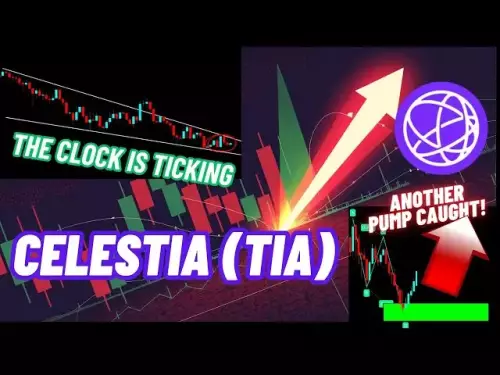-
 Bitcoin
Bitcoin $109800
0.96% -
 Ethereum
Ethereum $4462
-0.28% -
 Tether USDt
Tether USDt $1.000
0.01% -
 XRP
XRP $2.821
-0.71% -
 BNB
BNB $861.7
0.16% -
 Solana
Solana $202.1
-1.48% -
 USDC
USDC $1.000
0.03% -
 Dogecoin
Dogecoin $0.2184
0.01% -
 TRON
TRON $0.3411
-0.35% -
 Cardano
Cardano $0.8371
0.97% -
 Chainlink
Chainlink $23.72
-0.38% -
 Hyperliquid
Hyperliquid $45.31
1.40% -
 Ethena USDe
Ethena USDe $1.001
0.03% -
 Sui
Sui $3.324
-0.19% -
 Stellar
Stellar $0.3621
0.40% -
 Bitcoin Cash
Bitcoin Cash $547.2
-0.56% -
 Avalanche
Avalanche $24.23
0.46% -
 Cronos
Cronos $0.2828
-3.05% -
 Hedera
Hedera $0.2226
-1.80% -
 UNUS SED LEO
UNUS SED LEO $9.611
0.32% -
 Litecoin
Litecoin $110.7
-0.96% -
 Toncoin
Toncoin $3.157
0.51% -
 Shiba Inu
Shiba Inu $0.00001250
0.45% -
 Polkadot
Polkadot $3.851
0.19% -
 Uniswap
Uniswap $9.753
-1.24% -
 Dai
Dai $0.9999
0.00% -
 Bitget Token
Bitget Token $4.570
0.11% -
 Monero
Monero $268.2
2.03% -
 Aave
Aave $316.7
-1.64% -
 Ethena
Ethena $0.6473
-4.43%
What is a bull market versus a bear market in crypto?
In crypto bull markets, rising prices, FOMO, and institutional adoption drive momentum, while bear markets, though painful, foster innovation and set the stage for future growth.
Sep 01, 2025 at 02:00 am

Bull Market Dynamics in the Cryptocurrency Space
1. A bull market in crypto is characterized by rising prices across major digital assets, often fueled by increased investor confidence, institutional adoption, and positive regulatory developments. During such periods, Bitcoin and Ethereum typically set new all-time highs, pulling smaller altcoins upward through market momentum.
2. Trading volumes surge as retail participation grows, with social media platforms amplifying bullish sentiment. Investors begin reallocating capital from traditional markets into crypto, drawn by narratives of financial disruption and technological innovation.
3. New projects launch via initial coin offerings or decentralized launches, often achieving rapid valuation increases. Venture capital flows into blockchain startups, further validating the space and contributing to a self-reinforcing cycle of investment and price appreciation.
4. In a crypto bull market, fear of missing out (FOMO) becomes a dominant psychological driver, pushing even risk-averse individuals to enter positions they might otherwise avoid. Exchanges report record sign-ups, and on-chain metrics such as active addresses and transaction counts reflect heightened network usage.
5. Market breadth expands beyond flagship tokens, with sectors like DeFi, NFTs, and Layer 1 blockchains experiencing explosive growth. This broad participation signals a mature phase of the bull cycle, where speculative energy spreads across diverse use cases within the ecosystem.
Bear Market Realities and Structural Shifts
1. A bear market emerges when prices decline consistently over an extended period, typically following a peak in sentiment and valuation. Corrections of 50% or more from highs are common, and prolonged sideways or downward movement erodes investor enthusiasm.
2. Trading volumes dry up as speculative interest wanes. Retail traders reduce activity, and margin positions are liquidated en masse during sharp downturns, exacerbating price drops through cascading sell-offs.
3. Projects with weak fundamentals or insufficient funding fail to survive, leading to consolidation within the industry. Exchange delistings increase, and many startups shut down due to inability to secure further capital.
4. Despite the negative price action, bear markets often foster technical innovation and protocol improvements, as development teams focus on building rather than fundraising. Open-source contributors continue refining scalability, security, and interoperability features without the distraction of volatile markets.
5. On-chain data reveals accumulation patterns, where long-term holders increase their stakes at lower prices. This quiet accumulation sets the foundation for future cycles, though it occurs beneath the surface of public attention.
Market Transitions and Behavioral Indicators
1. The shift between bull and bear phases is rarely abrupt, often signaled by divergences in price and volume. For instance, a failure to break past previous highs on diminishing volume may indicate weakening momentum.
2. Whale movements become critical indicators, with large transfers to exchanges often preceding sell-offs. Conversely, extended holding periods by major addresses suggest confidence in future valuation recovery.
3. Derivatives markets reflect changing sentiment through funding rates and open interest. Sustained negative funding in perpetual swaps indicates bearish positioning, while extreme positive rates during rallies hint at over-leveraged long positions vulnerable to crashes.
4. Media narratives pivot from 'the next trillion-dollar asset' to 'crypto is dead,' influencing public perception. However, infrastructure development continues, with node operators, miners, and validators maintaining network integrity regardless of price.
5. Regulatory scrutiny tends to intensify after bull runs, as authorities respond to consumer complaints and financial stability concerns. Enforcement actions can trigger short-term panic but also lead to clearer legal frameworks over time.
Frequently Asked Questions
What on-chain metrics help identify a bull market?Rising transaction counts, increasing active addresses, growing exchange inflows from long-term holders, and higher wallet creation rates are strong signals. Additionally, declining supply on exchanges suggests accumulation, often preceding upward price movement.
How do leverage and margin trading impact bear markets?High leverage amplifies downside volatility. When prices drop, margin calls trigger forced liquidations, accelerating declines. This creates a feedback loop where falling prices lead to more selling, deepening the bear market's severity.
Can a crypto bear market last for years?Yes, previous bear markets have lasted between 18 months to over three years. The 2018–2020 downturn followed the ICO bubble, while the post-2021 cycle saw extended compression due to macroeconomic tightening and industry-specific failures.
Do halving events always lead to bull markets?Historically, Bitcoin halvings have preceded bull runs, but with a lag of 6 to 18 months. The mechanism—reducing new supply—interacts with demand factors. However, external conditions like regulation or global liquidity play equally important roles in determining market direction.
Disclaimer:info@kdj.com
The information provided is not trading advice. kdj.com does not assume any responsibility for any investments made based on the information provided in this article. Cryptocurrencies are highly volatile and it is highly recommended that you invest with caution after thorough research!
If you believe that the content used on this website infringes your copyright, please contact us immediately (info@kdj.com) and we will delete it promptly.
- Memecoins September 2025 Watchlist: What's Hot Now?
- 2025-08-31 23:25:15
- Eric Trump Predicts Bitcoin to $1 Million: Hype or Reality?
- 2025-08-31 23:25:15
- BlockDAG: Redefining Scalability and ROI Potential in 2025
- 2025-08-31 23:05:16
- Ozak AI, Altcoins, and 20x Potential: Navigating the Crypto Landscape
- 2025-09-01 00:05:12
- Bonk Price, Solana Meme Coin, and the Rise of Layer Brett: A New Era?
- 2025-08-31 21:25:12
- ETH Transactions Soar, BTC Whale Shifts Gears: Decoding August's Crypto Charts
- 2025-08-31 21:05:16
Related knowledge

What is the halving in Bitcoin?
Aug 30,2025 at 10:18pm
Understanding Bitcoin Halving1. The Bitcoin halving is an event coded into the blockchain’s protocol that reduces the reward miners receive for valida...

What are the different consensus mechanisms in blockchain?
Sep 01,2025 at 03:54pm
Proof of Work and Its Role in Blockchain Security1. Proof of Work (PoW) is one of the earliest and most widely recognized consensus mechanisms, primar...

What is a testnet versus a mainnet?
Aug 30,2025 at 06:54pm
Understanding the Role of Testnets in Blockchain Development1. A testnet serves as a parallel blockchain environment designed specifically for develop...

What are some common crypto scams to avoid?
Sep 01,2025 at 06:18am
Crypto Scams Involving Fake Exchanges1. Fraudulent platforms often mimic legitimate exchanges by using similar names and logos to deceive users. These...

What are crypto faucets?
Aug 30,2025 at 08:10am
Understanding Crypto Faucets1. Crypto faucets are online platforms that distribute small amounts of cryptocurrency to users for completing simple task...

What are privacy coins?
Aug 30,2025 at 06:18am
Understanding Privacy Coins in the Cryptocurrency Ecosystem1. Privacy coins are a category of cryptocurrencies specifically designed to enhance transa...

What is the halving in Bitcoin?
Aug 30,2025 at 10:18pm
Understanding Bitcoin Halving1. The Bitcoin halving is an event coded into the blockchain’s protocol that reduces the reward miners receive for valida...

What are the different consensus mechanisms in blockchain?
Sep 01,2025 at 03:54pm
Proof of Work and Its Role in Blockchain Security1. Proof of Work (PoW) is one of the earliest and most widely recognized consensus mechanisms, primar...

What is a testnet versus a mainnet?
Aug 30,2025 at 06:54pm
Understanding the Role of Testnets in Blockchain Development1. A testnet serves as a parallel blockchain environment designed specifically for develop...

What are some common crypto scams to avoid?
Sep 01,2025 at 06:18am
Crypto Scams Involving Fake Exchanges1. Fraudulent platforms often mimic legitimate exchanges by using similar names and logos to deceive users. These...

What are crypto faucets?
Aug 30,2025 at 08:10am
Understanding Crypto Faucets1. Crypto faucets are online platforms that distribute small amounts of cryptocurrency to users for completing simple task...

What are privacy coins?
Aug 30,2025 at 06:18am
Understanding Privacy Coins in the Cryptocurrency Ecosystem1. Privacy coins are a category of cryptocurrencies specifically designed to enhance transa...
See all articles

























































































